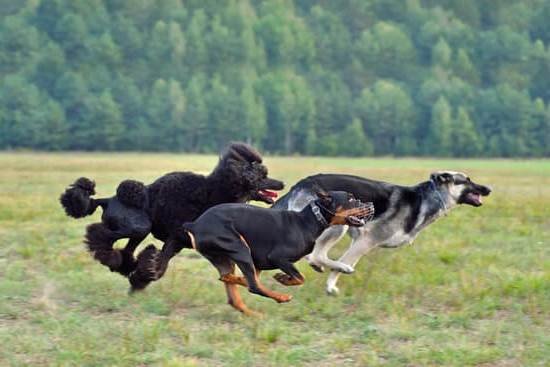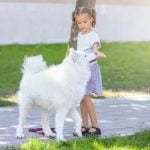Are you looking for the easiest dogs to train? Training your furry friend is not only important for their own safety and well-being, but it also enhances the bond between you and your pet.
In this article, we will explore the benefits of dog training, the characteristics of easily trainable dogs, top breeds known for their trainability, effective training techniques, common challenges in training, success stories of well-trained dogs, and resources available to help you on your training journey.
Training your dog is a crucial part of being a responsible pet owner. It not only teaches them obedience but also provides mental stimulation and helps build a strong bond with their human companions. When you choose a dog breed that is easy to train, it can make the process even more enjoyable and rewarding for both you and your four-legged friend.
In the following sections, we will discuss how training can improve the bond between you and your dog, what to look for when choosing a dog breed, effective training techniques such as positive reinforcement and consistency, addressing common challenges in training, real-life examples of well-trained dogs, and resources available to further assist you in your training journey.
Whether you are a first-time pet owner or an experienced trainer looking for new insights, this article will provide valuable information on finding and training one of the easiest dogs to train.
Benefits of Training
The bond between a dog and its owner is truly special, and training plays a crucial role in strengthening this bond. Beyond just teaching basic commands, training provides an opportunity for you to communicate with your dog, build trust, and establish a deeper connection. By investing time and effort into training, you can create a more harmonious and fulfilling relationship with your furry companion.
One of the key benefits of training is the development of mutual understanding. Through consistent training sessions, you and your dog learn to understand each other’s cues, body language, and communication style. This understanding fosters a sense of cooperation and teamwork, allowing you to navigate various situations together with ease.
Additionally, training provides mental stimulation for dogs. Canine cognitive enrichment is essential for overall well-being, and training activities offer a way for dogs to engage their minds and problem-solving skills. As a result, trained dogs are often more confident, adaptable, and capable of handling new experiences.
Furthermore, well-trained dogs tend to have fewer behavioral issues, making them more enjoyable companions both at home and in public settings. By teaching obedience and good manners through training, you can enhance your dog’s social interactions with people and other animals.
| Benefit | Description |
|---|---|
| Mutual Understanding | Training fosters cooperation and teamwork between owner and dog through communication. |
| Mental Stimulation | Training activities engage dogs’ minds and problem-solving skills for overall well-being. |
| Improved Behavior | Well-trained dogs exhibit fewer behavioral issues, making them better companions at home and in public. |
Characteristics of Easily Trainable Dogs
When choosing a dog breed, it’s important to consider the characteristics that make certain breeds easier to train. The temperament and personality traits of a dog can greatly affect how well they respond to training. Here are some key traits to look for when considering easily trainable dogs:
1. Intelligence: Dogs that are quick learners and have high levels of intelligence tend to be easier to train. They can quickly pick up on commands and understand what is expected of them.
2. Eagerness to please: Breeds that are eager to please their owners are often more motivated to learn and follow commands. They are typically more responsive to positive reinforcement during training sessions.
3. Socialization: Dogs that are naturally friendly and social with both humans and other animals tend to be more adaptable to different training environments and situations.
When looking for easily trainable dogs, there are several breeds that consistently rank high in trainability. Some of the top breeds known for their ease of training include:
These breeds often possess the intelligence, eagerness to please, and socialization skills that make them highly receptive to training.
By taking into account these characteristics and choosing a breed known for its ease of training, you can set yourself up for a successful training experience with your new furry friend.
Top Breeds
When it comes to the easiest dogs to train, certain breeds stand out for their intelligence, willingness to please, and ability to learn commands quickly. If you are looking for a new furry friend that is easy to train, then consider the following top breeds:
- Labrador Retriever: This breed is known for its friendly nature and eagerness to learn. Labs are highly trainable and excel in obedience training, agility, and therapy work. Their gentle demeanor makes them great family pets as well.
- Border Collie: Border Collies are incredibly intelligent and have a strong work ethic, making them one of the easiest dogs to train. They thrive on mental stimulation and excel in various dog sports such as flyball, obedience trials, and herding competitions.
- Poodle: Poodles are not only hypoallergenic but also highly trainable. They are known for their intelligence and versatility, excelling in various dog sports such as agility, obedience, and tracking. Poodles also make loyal companions and great family pets.
- German Shepherd: Known for their loyalty and courage, German Shepherds are easily trainable due to their high intelligence and desire to work. They excel in obedience training, protection work, search-and-rescue operations, and police K-9 units.
These breeds not only possess the qualities of being the easiest dogs to train but also make wonderful companions for individuals or families looking for a well-behaved pet.
Whether you choose one of these top breeds or a different breed altogether, training your dog using positive reinforcement techniques such as treats, praise, and play will help strengthen the bond between you and your furry friend. Consistency in training is key regardless of the breed chosen. By understanding each dog’s individual personality traits and motivation factors, you can tailor your training approach to suit their specific needs.
Techniques for Training
When it comes to training your dog, using the right techniques can make all the difference in the world. Positive reinforcement, clicker training, and consistency are three effective methods that can help you train your dog in the most efficient and enjoyable way possible.
Positive Reinforcement
One of the easiest dogs to train responds well to positive reinforcement. This technique involves rewarding your dog with treats, praise, or toys when they exhibit good behavior. By doing this, you are reinforcing the behavior you want to see more of. For example, if you’re teaching your dog to sit, as soon as they sit down, give them a treat and praise them. This will let them know that sitting is a desired behavior.
Clicker Training
Clicker training is another popular method for training dogs. It involves using a small device called a clicker to make a clicking sound every time your dog performs a desired behavior. The click is immediately followed by a reward, such as a treat or praise. Over time, your dog will learn to associate the clicking sound with receiving a reward for their behavior.
Consistency
Consistency is key when it comes to training any dog breed. This means using the same commands and cues every time, and enforcing rules consistently. Dogs thrive on routine and repetition, so consistency in training will help them understand what is expected of them. Whether it’s potty training or teaching new tricks, being consistent in your approach will help your dog learn more quickly and effectively.
By using these techniques for training, you can improve the bond between you and your furry friend while also having fun along the way. Remember that different dogs may respond better to different methods, so be patient and find what works best for you and your pup.
Common Challenges in Training
Training a dog can be a rewarding experience, but it also comes with its fair share of challenges. One common challenge that dog owners face is stubbornness in their pets. Some breeds are naturally more independent and strong-willed, making it difficult to get them to follow commands consistently. However, with patience and the right techniques, even the most stubborn dogs can become well-behaved and obedient.
Distractions are another obstacle that dog owners often have to deal with during training. Whether it’s other animals, loud noises, or interesting smells, dogs can easily lose focus during training sessions. It’s important for owners to create a distraction-free environment when training their dogs and to gradually introduce distractions as the dog becomes more proficient in following commands.
Fear is yet another challenge that some dogs may face during training. This fear could be related to certain objects, people, or situations that make the dog anxious and hesitant to follow commands. Understanding the source of your dog’s fear is crucial in addressing this issue and helping them overcome it through positive reinforcement and gradual exposure.
| Challenges | Addressing Techniques |
|---|---|
| Stubbornness | Patience, positive reinforcement, consistent training |
| Distractions | Create a distraction-free environment, gradually introduce distractions |
| Fear | Identify source of fear, use positive reinforcement, gradual exposure |
Success Stories
Many dog owners have experienced the joy and satisfaction of successfully training their furry companions. Real-life success stories can serve as inspiration and guidance for those seeking to train their own dogs. These stories demonstrate that with dedication, patience, and the right techniques, even the most challenging breeds can become obedient and well-behaved pets.
Labrador Retriever: A Natural Learner
One common success story is the Labrador Retriever, known for being one of the easiest dogs to train. Their intelligence, eagerness to please, and sociable nature make them quick learners. A well-trained Labrador can excel in obedience, agility, and even therapy work. Many Labradors have become certified assistance dogs, providing invaluable support to individuals with disabilities or special needs.
Border Collie: The Ultimate Working Dog
Another impressive success story comes from the Border Collie, a breed renowned for its remarkable intelligence and herding instincts. While their high energy levels can pose a challenge for some owners, with proper training and outlets for physical and mental stimulation, Border Collies can excel in various canine sports and activities such as agility trials, flyball competitions, and obedience trials.
Poodle: Masters of Performance
Poodles are widely recognized for their intelligence and versatility. From loyal family pets to skilled performers in dog shows, poodles consistently impress with their ability to learn new commands and routines. Their hypoallergenic coat also makes them a popular choice for owners with allergies. With appropriate training methods tailored to their sensitive nature, poodles can thrive in various environments and roles.
These real-life examples of well-trained dogs highlight the potential of different breeds when provided with effective training and positive reinforcement methods. Whether it’s through basic obedience or specialized tasks, these success stories demonstrate that any dog can reach its full potential with the right approach.
Training Resources
In conclusion, when it comes to finding the best furry companion for training, understanding the characteristics of easily trainable dogs is crucial. The Labrador Retriever, Border Collie, Poodle, and German Shepherd are considered some of the easiest dogs to train due to their intelligence, eagerness to please, and ability to learn quickly. However, it’s important to remember that each dog is unique, and success in training ultimately depends on the owner’s commitment and consistency.
By investing time and effort into training your dog, you not only help them become well-behaved companions but also strengthen the bond between you and your pet. Training provides mental stimulation for your dog and gives them a sense of purpose and accomplishment. It can also improve their overall behavior and obedience while fostering a positive relationship based on trust and clear communication.
For those looking to embark on a training journey with their furry friend, there are various resources available including books, online courses, and professional trainers. These resources can provide valuable guidance and support in implementing effective training techniques such as positive reinforcement and clicker training. Ultimately, with patience, dedication, and the right tools at hand, any dog owner can achieve success in training their beloved companion.
Frequently Asked Questions
Which Is the Easiest Dog to Train?
The easiest dog to train is often considered to be the Border Collie. Their intelligence and eagerness to please make them quick learners when it comes to obedience commands and tricks. They thrive on mental stimulation and are very responsive to training.
What Is Hardest Dog to Train?
On the other hand, the hardest dog to train is usually considered to be the Afghan Hound. Known for their independent nature and aloof demeanor, Afghan Hounds can be quite stubborn when it comes to training. They require a patient and consistent approach.
Which Is the Easiest Dog to Own?
When it comes to the easiest dog to own, many people would say that small breeds like the Maltese or Cavalier King Charles Spaniel are great options. These dogs typically adapt well to living in smaller spaces and are generally low maintenance in terms of exercise and grooming needs. Additionally, their affectionate nature makes them wonderful companions for their owners.

Welcome to the blog! I am a professional dog trainer and have been working with dogs for many years. In this blog, I will be discussing various topics related to dog training, including tips, tricks, and advice. I hope you find this information helpful and informative. Thanks for reading!





